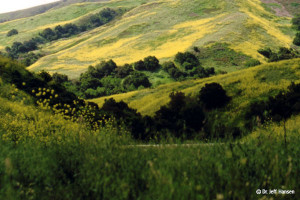 Many parts of the Puente-Chino Hills Wildlife Corridor still have the kind of natural plants, trees, and shrubs that have been growing here for thousands of years.
Many parts of the Puente-Chino Hills Wildlife Corridor still have the kind of natural plants, trees, and shrubs that have been growing here for thousands of years.
Other parts of the hills have been overwhelmed by non-native plant species that were introduced and spread primarily by sheep and cattle ranching over the past several hundred years. These non-native plants include the grasses and mustard that are so common today.
Restoration is tricky business requiring carefully devised protocols. For example, the non-native plants are removed but then a succession of vegetation is immediately planted to keep the soil alive and healthy. Irrigation is brought in to establish the plants, once healthy native plants are thriving, the irrigation is removed, and the plants are “on their own.”
Restoration of native plants is a long-term goal in the Puente-Chino Hills Wildlife Corridor. Native plants resist fire better than non-native plants and native plants provide better habitat for the array of wildlife that are supposed to be here.
- Chino Hills State Park
Learn about the 20 years of restoration efforts at the State Park. - Carbon Creek (Brea/Chino Hills)
Read about the role of Arundo donax in the Freeway Complex Fire (2008) and efforts to remove this non-native plant from the watershed. - Puente Hills Preserve
Discover the restoration work on the protected lands owned by the Habitat